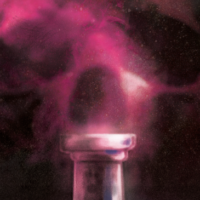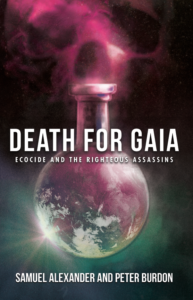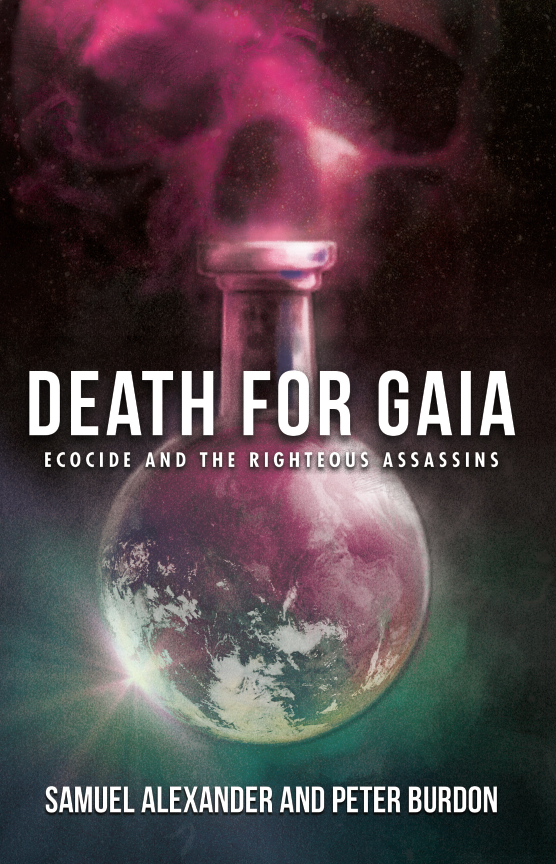Death for Gaia: Ecocide and the Righteous Assassins
In the middle of last year I finished the manuscript of a book called Death for Gaia: Ecocide and the Righteous Assassins, co-authored with Associate Professor Peter Burdon, of Adelaide Law School, Australia. Believe it or not, the book is a work of philosophical fiction about a global pandemic, although given the timeline any similarities with the existing situation are obviously coincidental.
With the emergence of COVID-19 we’ve been hesitant to publicise it, but we’ve decided to share news of it with our most trusted immediate networks, including our friends at the Simplicity Collective. If a philosophical narrative about a virus is not something you’re interested in reading right now, we totally understand! Read no further. If, however, you might be perversely tempted, the paperback is available at various places here and the ebook is available on a ‘pay what you want’ basis here (including for free). We’ve posted the blurb below, followed by the introductory chapter. We recognise that the publication of this book comes at a very sensitive moment, but we trust that it will be received in a genuine spirit of unfiltered intellectual and ethical inquiry.
Here is the text from the back of the book:
Death for Gaia is a philosophical story about a group of scientists who create and release a biological weapon they call ‘Hemlock-42’. This virus is designed with a single goal in mind: to eradicate most of humanity as a means of preserving what remains of planetary ecosystems and the declining diversity of species. Less than ten percent of humanity survives the pandemic.
Forty-six years after this momentous disruption, various tribes of the After World have gathered, in this period of fragile but renewed stability, to discuss the justifiability of the acts that led to the Great Die-Off. Professor Durruk Senjen, the sole surviving activist who released Hemlock-42, has been called to defend his acts and face judgement.
Note from the authors: Readers will quickly draw parallels between the fictional virus described in this book and the outbreak of COVID-19 at the beginning of 2020. Our manuscript was complete and under review in July 2019 and so any similarities are purely coincidental. We offer this book with condolences to those who have lost loved ones to the pandemic.
Introduction to Death for Gaia: ‘The Final Warning’
In the year 2027, the Association of Concerned Earth Scientists (ACES) published a ‘final warning to humanity’. Over one thousand pages long – and the most peer-reviewed document in human history – it detailed with forensic precision the catastrophic environmental impacts of human activity and urgently called for fundamental changes to what were described as civilisation’s ‘destructive tendencies’. The scientific report was accompanied by executive summaries, policy documents, guidance for activists, and an almost embarrassingly slick public relations campaign, copiously funded by anonymous philanthropists. For a short time, the ‘final warning’ was in the newspapers and a topic of cultural conversation.
Four months after publication, however, it had been forgotten, and the politics of willful blindness resumed. Radicalised by this ongoing global inaction and apathy, a secret faction developed within the board of ACES. These vigilantes were determined to make an impact on civilisation by taking things into their own hands, in order to contain what one of them described as the ‘human plague’. Within a matter of months this underground collective of despairing scientists had developed a biological weapon they called ‘Hemlock-42’. This virus, named after the poison used to execute Socrates, was designed with a single goal in mind: to eradicate most of humanity, as a means of preserving what remained of the biosphere and its dwindling diversity of species. Less than ten percent of the human population had a genetic immunity to the disease and those people were scattered randomly around the world.
The first two scientific warnings to humanity, published in the years 1992 and 2017, had gone unheeded, failing to change the trajectory of industrial civilisation. When the third warning also fell on deaf ears, the highly contagious Hemlock-42 was released, killing approximately seven-and-a-half-billion people within months. Best estimates place the surviving population at just under one billion people.
Thus industrial civilisation came to an abrupt and harrowing end.
* * *
A new age dawned in the chaotic aftermath. With the human population decimated by the virus and the systems of global capitalism shattered, Gaia was able to take pause from the onslaught of industrialism – just as the vigilantes had hoped. For the remaining wanderers of Earth it was surprising how quickly nature reclaimed her space in even the most ‘civilised’ of places. While plastics remained, the air and waters cleared of pollution, the forests slowly remerged in the forgotten fields of agriculture, and wildlife dared to walk or fly through the eerily quiet streets of central business districts. It wasn’t long before the supermarket shelves were emptied by hungry survivors, suddenly aware of their dependency on dead modes of production and distribution, and in time the electricity and water grids stopped functioning. The Internet became a matter of lore and legend, such that children of the After World were never sure it had actually existed. To them it seemed quite implausible.
Suffering was everywhere, but so were beauty, peace, and regeneration. There is no short or easy means of describing the ways of living that emerged after the Great Die-Off. Suffice to say that the one-dimensionality of globalised, consumer culture disintegrated into fragments of local survivalism, adaptation, and frugal creativity. In the search for security, some banded together as marauders in the hope of reclaiming the false promises of affluence. But overall humanity fell into, or actively sought to establish, new and diverse forms of what was once called tribal community, making the best of a dead civilisation on a beautiful planet.
Some tribes hunted and gathered; others formed small farming communities; but most of what remained of humanity came to participate in various, hybrid forms of the salvage economy, reinhabiting empty buildings in the suburbs, inheriting ‘abandoned’ farms, bartering here and there with neighbouring communities, and basically making do with what they could find in the abundant treasures and waste streams of industrial civilisation. The cities of old had become as sparsely populated as the rural regions, and communication between bioregions was slow or non-existent. Fragments of news about far-away places sometimes arrived by way of sail or horse-and-carriage, and occasionally, in places, a car or truck would move slowly through the streets, powered by the last drops of ancient sunlight or fat scraped from the bottom of a deep-fryer. Everything was turned upside down and inside out, never to be the same.
* * *
Forty-six years after this momentous disruption, various tribes of the After World have gathered, in this period of fragile but renewed stability, to discuss the justifiability of the acts that led to the Great Die-Off. Professor Durruk Senjen, the sole surviving activist who released Hemlock-42, has been called to defend his acts and face judgement. After living in exile for an indeterminate number of years, Senjen eventually became a wandering tradesman under cover of disguise, but several months ago he was recognised by two aging farmers as the man who created the virus. He was immediately detained and locked in a stone tower, where he has remained. As news of this slowly spread, thousands of people have travelled from far and wide to discuss what is to be done with him. Senjen has reluctantly agreed to explain himself, seeing no alternative, and attends the gathering of the tribes as a free man, albeit one fearing for his life.
The question under consideration: Was it right to deliberately destroy industrial civilisation, with all the human death and suffering this brought, for the sake of maintaining a healthy and thriving planet? Or was it a heinous, arrogant, and unjustifiable crime for which the surviving perpetrator should be held accountable? Given that there are no longer any legal institutions or codes, these proceedings are not intended to be a ‘trial’ in the old sense. Instead, they were conceived of as explorations in truth, understanding, and the possibility of reconciliation, all the while knowing that many people would come with a hunger for retribution and punishment.
Zola Eblo, a respected elder of a distant community, has gained a reputation as a skilled healer and has earned the trust of her community through the patient hours she has spent nursing the unwell back to health or easing their transition into death and beyond. Because Zola stands at the veil between life and death she is also regarded as a spiritual guide who can be turned to in times of trouble.
When news of Senjen’s detainment reached her community, Zola went quiet for several days. She withdrew from her community and sought solitude in a woodland on the outskirts of her village. There, in the midst of nature, she entered a meditative trance for three days and three nights, and when the wind blew from the East the townspeople could hear her singing faintly on the breeze. When Zola emerged, she was sombre, as though carrying a great weight on her shoulders. She sent a messenger to the community that was holding Senjen, offering to facilitate the discussion. Her offer was gratefully accepted.
The following text is a transcript of the discussion that took place around a fire pit, in the ruins of what was once a great city, in the year 2073.
The paperback is available at various places here and the ebook is available on a ‘pay what you want’ basis here (including for free).
Several of my other e-books are also available on a ‘pay what you want’ basis here.






